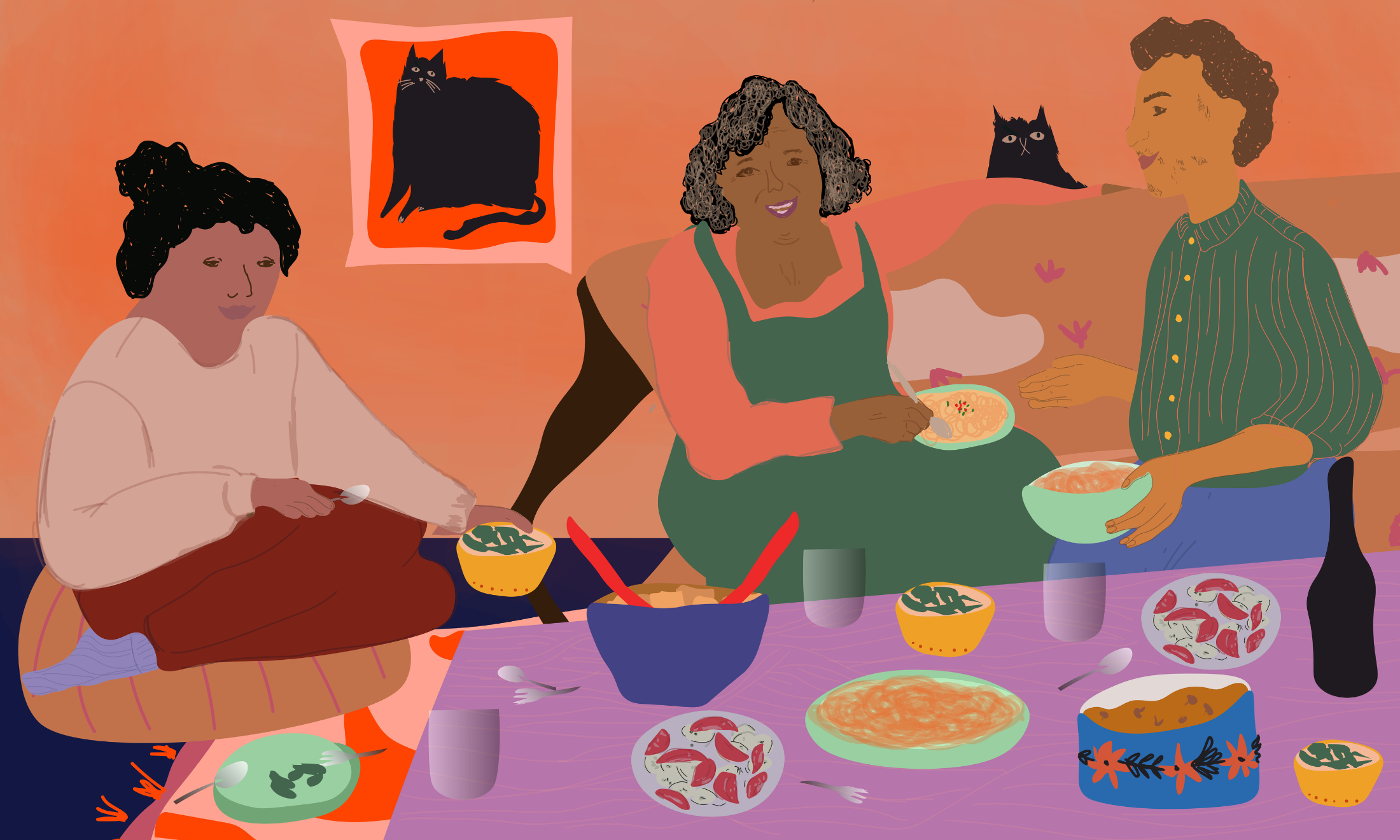
Hayfaa Chalabi
Against the binary: Clothes shopping as a trans person is an *experience*
The cis-gaze feels particularly tangible when you're buying clothes as a trans person, but is it possible to overcome it?
Yas Necati and Editors
30 Sep 2021
Welcome back to gal-dem’s monthly gender column ‘Against the binary’, bringing you Yas Necati’s latest reflections on finding gentleness, home and joy as a trans person.
I will never forget the first time I bought a pair of boxers at the shopping mall. As soon as I got home and was behind closed doors, I slipped into them and everything felt so easy and comfortable. It was like I was seeing myself as… myself, for the first time. Ultimately it was just an item of fabric, but the boxers represented so much more than that; they were what I’d been told my whole life wasn’t for me, and here I was, wearing them anyway. It’s amazing how something as mundane as underwear can feel so significant and embodying.
Despite finding the joy of wearing clothes that fit me, shopping in the ‘men’s section’ hasn’t always been that easy. As IRL shops open up again, I’m having to navigate what it means to re-enter gendered spaces, and how I’ll shop for shirts and underwear.
Every trans person I know has experienced some kind of nonsense question when shopping for clothes. From “Is this for your dad/sister/boyfriend/[insert random person of another gender]?” to the strange side eyes we get across the aisle, we risk violence that cis people so often impose on us when we step outside of their gendered lines. This violence is not always physical, but it is in the looks people give, comments made, binaries that are policed and enforced unspoken. We feel the violence set and enforced from an early age, before we really understand what gender means for us and how we want to outwardly present to the world.
“I’m having to navigate what it means to re-enter gendered spaces, and how I’ll shop for shirts and underwear”
One of my first instances of this violence was when I was 11 years old. There was a boy in my class called Zack and we had the same trousers. I remember them quite distinctly – they were baggy cargo pants (excellent for climbing trees) and they had a lot of pockets, one of my favourite features as I liked to collect rocks from the school playground. One non-uniform day, me and Zack both wore our trousers to school and gave each other a smile, a shared acknowledgement. If that was the end of the story, I probably wouldn’t remember it and I probably wouldn’t remember those particular cargo pants so well. But these were the cargo pants that made me realise I would be safer if I dressed in accordance with other people’s gendered lines.
Some other kids in our class clocked that I was wearing ‘boy’s clothes’. I don’t even remember what they said, I just remember the feelings; humiliation, embarrassment and fear. I was on the cusp of secondary school, and the next time we went clothes shopping, I pulled my mum aside and whispered, the shame so heavy on my lips, “Can I wear girls clothes now?”. I wish she had challenged me, but I can’t blame her for not doing so. She could see her child being bullied and that can’t have been easy.
I often think back on how I felt as a child – I didn’t really see the pink and blue signs in shops, I just went for clothes that felt right for me. I naturally gravitated towards ‘boy’s clothes’ because they were more practical for playing outdoors, and that’s what I loved. I liked the colours better and I was frustrated that I could never find any jeans in the ‘girl’s section’ that didn’t have butterflies or pink sequins sewn into them. Even at that age, I never really understood why we gendered clothes. I still don’t get why we have shops full of all this fabric sewn into shapes and we split a line down the middle, enforcing which fabric is for who.
“Without the cis gaze, things happened that I didn’t expect”
By the time I worked up the courage to go to the ‘men’s section’ again, I was in my late teens. This was a time before, when internet shopping wasn’t really a thing. I started with checked shirts and ripped jeans. I felt like a deer in a forest, the clothes racks like trees I hid behind. I was hyper vigilant with each corner I turned, avoiding the other shoppers, mostly men who were much bigger and taller than me. I felt like I was hiding something, like I had to be discreet. I felt the shame and fear flood back. But coupled with this was a sense of triumph – I had made it back to the clothes that felt right, after so many years of denying myself of that. I was undercover for myself. It felt freeing, rebellious, exciting. The stealth of the shop floor was worth it when I got home and slipped into boxers, bound my chest and pulled on a cute shirt.
Since that instance, my experience of clothes shopping in public has always been like this. The vigilance and the shame building up, the rush of euphoria afterwards. However over lockdown, as I shifted to getting the occasional shirt online, things became different. There were no cis people watching. And without the cis gaze, things happened that I didn’t expect – I glanced at the ‘women’s section’. I really did start to look at clothes as genderless, rather than looking for what would be perceived as most ‘masculine’, so that I could hide behind it. I had spent so many years feeling pressured into wearing ‘women’s clothes’ that I had been avoiding them entirely in an attempt to be defiant. But I realised I was doing exactly what I had never wanted to – picking my clothes based on the gender label they were under.
“We risk violence that cis people so often impose on us when we step outside of their gendered lines”
When shops opened up again, I challenged myself to venture to the ‘women’s section’ in person. Now that I feel more comfortable in my gender, I don’t necessarily feel so tied to external markers like clothes to try to stop strangers misgendering me as what I was assigned at birth. They are going to misgender me anyway, so I might as well just wear whatever I feel like.
I went to a shop and into every corner of it, trying things based on what they looked like, rather than what label they were under. I was a child again, guided simply by what felt most right. I did gravitate mostly towards ‘men’s clothes’, like I always have done, but there were things in the ‘women’s section’ that caught my eye too. For the first time, I actually felt really confident, and I think it’s because I’ve been away from the cis gaze for a long time. There were people with their expectations, but I was floating past them, some kind of shapeshifter in a form that fit seamlessly into any section of the shop.
I reminded myself that just because cis people see me under their gaze, I don’t have to see myself under it. Just because they put me under their gaze, doesn’t mean I have to internalise it. And when they – or even my subconscious socialisation – tries to enforce that binary gaze, I will do everything I can to keep myself safe, including continuing to dress for myself and not for them.








